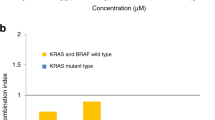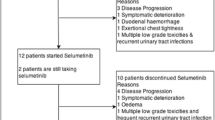Abstract
Purpose
Advanced biliary tract adenocarcinoma (BTA) is a rare tumor with a poor prognosis. Since no standard salvage chemotherapy regimen exists, we explored the activity of capecitabine alone or combined with mitomycin C.
Methods
Patients aged 18–75 years and with KPS >50, with pathological diagnosis of BTA stratified based on site and stage of disease, were randomized to receive capecitabine 2000 mg/m2 day 1–14 alone (ARM A) or in combination with mitomycin C 6 mg/m2 day 1 (ARM B) as second-line therapy. Cycles were repeated in both arms every 3 weeks. Tumor assessment was performed every 2 months. The primary endpoint was the probability of being progression free at 6 months (PFS-6) from treatment start. According to the Fleming design, the study aimed to enroll 26 pts per arm. An exploratory endpoint was to assess thymidylate synthase (TS) and thymidine phosphorylase (TP) expression, as biomarkers predictive for clinical outcomes of capecitabine treatment.
Results
Between October 2011 and 2013, 57 metastatic pts were enrolled: ARM A/B 28/29. Accordingly, 55 (26/29) pts were assessable for the primary endpoint: 2 (8 %) ARM A and 3 (10 %) ARM B pts were PFS-6. Main G3-4 toxicities were: hand-foot syndrome and transaminitis in 4/0 %, and thrombocytopenia, diarrhea and fatigue in 0/3 % of pts. No statistically significant correlation was found between TS or TP expression and pts’ outcome.
Conclusions
Since capecitabine yielded a disappointing outcome and the addition of mitomycin C did not improve the results, new therapeutic strategies need to be explored to improve survival in this disease setting.
Similar content being viewed by others
References
Glimelius B, Hoffman K, Sjoden PO (1996) Chemotherapy improves survival and quality of life in advanced pancreatic and biliary cancer. Ann Oncol 7:593–600
Sharma AB, Dwary AD, Mohanti BK et al (2010) Best supportive care compared with chemotherapy for unresectable gall bladder cancer: a randomized controlled study. J Clin Oncol 28:4581–4586
Valle J, Wasan HS, Palmer DH et al (2010) Cisplatin plus gemcitabine versus gemcitabine in biliary tract cancer. N Engl J Med 362:1273–1281
Marino D, Leone F, Cavalloni G, Cagnazzo C, Aglietta M (2013) Biliary tract carcinomas: from chemotherapy to targeted therapy. Crit Rev Oncol Hematol 85:136–148
Kornek GV, Schuell B, Laengle F et al (2004) Mitomycin C in combination with capecitabine or biweekly high-dose gemcitabine in patients with advanced biliary tract cancer: a randomised phase II trial. Ann Oncol 15:478–483
Taal BG, Audisio RA, Bleiberg H et al (1991) Phase II trial of mitomycin C (MMC) in advanced gallbladder and biliary tree carcinoma: an EORTC gastrointestinal tract cancer cooperative group. Ann Oncol 4:607–612
Crooke ST, Bradner WT (1976) Mitomycin C: a review. Cancer Treat Rev 3:121–139
Von Eyben F, Hellekant C, Matsson W et al (1980) Mitomycin C in advanced gallbladder carcinoma. Oncology 19:81–84
Patt YZ, Hassan MM, Aguayo A et al (2004) Oral capecitabine for the treatment of hepatocellular carcinoma, cholangiocarcinoma, and gallbladder carcinoma. Cancer 10:578–586
Gennatas C, Michalaki V, Gennatas S (2009) The role of capecitabine in the management of tumors of the digestive system. Rev Recent Clin Trials 4:1–11
Sawada N, Ishikawa T, Fukase Y et al (1998) Induction of thymidine phosphorylase activity and enhancement of capecitabine efficacy by taxol/taxotere in human cancer xenografts. Clin Cancer Res 4:1013–1019
Saeki T, Takashima S (1999) Mechanism and possible biochemical modulation of capecitabine (Xeloda), a newly generated oral fluoropyrimidine. Gan To Kagaku Ryoho 26:447–455
Therasse P, Arbuck SG, Eisenhauer EA et al (2004) New guidelines to evaluate the response to treatment in solid tumors. European Organization for Research and Treatment of Cancer, National Cancer Institute of the United States, National Cancer Institute of Canada. J Natl Cancer Inst 92:205–216
Common Terminology Criteria for Adverse Events (CTCAE) Version 4.0 Published: May 28, 2009 (v4.03: June 14, 2010)
Fleming TR (1982) One-sample multiple testing procedure for phase II clinical trials. Biometrics 38:143–151
Lee S, Park YH, Kim KH et al (2010) Thymidine synthase, thymidine phosphorylase, and excision repair cross-complementation group 1 expression as predictive markers of capecitabine plus cisplatin chemotherapy as first-line treatment for patients with advanced oesophageal squamous cell carcinoma. Br J Cancer 103:845–851
Mirza A, Brown M, McNulty C et al (2013) A pilot study to investigate the role of thymidylate synthase as a marker of prognosis for neoadjuvant chemotherapy in gastric and gastro-oesophageal junction adenocarcinoma. Gastroenterol Res Pract 2013:502153. doi:10.1155/2013/502153
Chen CY, Chang YL, Shih JY et al (2011) Thymidylate synthase and dihydrofolate reductase expression in non-small cell lung carcinoma: the association with treatment efficacy of pemetrexed. Lung Cancer 74:132–138
Cereda S, Belli C, Rognone A, Mazza E, Reni M (2013) Second-line therapy in advanced biliary tract cancer: what should be the standard? Crit Rev Oncol Hematol 88:368–374
Brandi G, Di Girolamo S, De Rosa F et al (2011) Second-line chemotherapy in patients with biliary tract cancer. J Clin Oncol 29:e14590
Roth A, Schleyer E, Schoppmeyer K et al (2011) Imatinib mesylate for palliative second-line treatment of advanced biliary tract cancer: a bicentric phase II study. Onkologie 34:469–470
Buzzoni R, Pusceddu S, Bajetta E et al (2014) Activity and safety of RAD001 (everolimus) in patients affected by biliary tract cancer progressing after prior chemotherapy: a phase II ITMO study. Ann Oncol 25:1597–1603
La Marca A, Hubner RA, Ryder WD, Valle JW (2014) Second-line chemotherapy in advanced biliary cancer: a systematic review. Ann Oncol 25:2328–2338
Fornaro L, Vivaldi C, Brandi G et al (2015) Outcome of second-line chemotherapy (CT2) after first-line CT (CT1) with platinum plus gemcitabine in advanced biliary tract cancer (aBTC): is it worthwhile? Ann Oncol 26 (suppl 4): iv42 (P-147) doi:10.1093/annonc/mdv233.147
Aschele C, Debernardis D, Casazza S et al (1999) Immunohistochemical quantification of thymidylate synthase expression in colorectal cancer metastases predicts for clinical outcome to fluorouracil-based chemotherapy. J Clin Oncol 17:1760–1770
Cascinu S, Aschele C, Barni S et al (1999) Thymidylate synthase protein expression in advanced colon cancer: correlation with the site of metastasis and the clinical response to leucovorin-modulated bolus 5-fluorouracil. Clin Cancer Res 5:1996–1999
Johnston PG, Mick R, Recant W et al (1997) Thymidylate synthase expression and response to neoadjuvant chemotherapy in patients with advanced head and neck cancer. J Natl Cancer Inst 89:308–313
Tominaga T, Toi M, Ohashi Y, Abe O (2002) Prognostic and predictive value of thymidine phosphorylase activity in early stage breast cancer patients. Clin Breast Cancer 3:55–64
Aschele C, Debernardis D, Bandelloni R et al (2002) Thymidylate synthase protein expression in colorectal cancer metastases predicts for clinical outcome to leucovorin modulated bolus or infusional 5-fluorouracil but not methotrexate-modulated bolus 5- fluorouracil. Ann Oncol 13:1882–1892
Tsuda H, Akiyama F, Kurosumi M, Sakamoto G (2004) Reproducible immunohistochemical criteria based on multiple raters’ judgements for expression of Thymidine phosphorylase in breast cancer tissue. Breast Cancer Res Treat 86:215–223
Andreetta C, Puppin C, Minisini A et al (2009) Thymidine phosphorylase expression and benefit from capecitabine in patients with advanced breast cancer. Ann Oncol 20:265–271
Lee SJ, Choi YL, Park YH et al (2011) Thymidylate synthase and Thymidine phosphorylase as predictive markers of capecitabine monotherapy in patients with anthracycline- and taxane-pretreated metastatic breast cancer. Cancer Chemother Pharmacol 68:743–751
Kim KW, Kwon H-C, Kim S-H et al (2013) Prognostic significance of thymidylate synthase, thymidine phosphorylase and dihydropyrimidine dehydrogenase expression in biliary tract cancer patients receiving adjuvant 5-fluorouracil-based chemotherapy. Mol Clin Oncol 1:987–994
Nishi M, Shimada M, Utsunomiya T et al (2011) Role of dihydropyrimidine dehydrogenase and thymidylate synthase expression in immunohistochemistry of intrahepatic cholangiocarcinoma. Hepatol Res 41:64–70
Fornaro L, Cereda S, Aprile G et al (2014) Multivariate prognostic factors analysis for second-line chemotherapy in advanced biliary tract cancer. Br J Cancer 110:2165–2169
Acknowledgments
An unrestricted Grant of Rete Oncologica Lombarda (ROL)—Regione Lombardia—supported this trial.
Author information
Authors and Affiliations
Corresponding author
Ethics declarations
Conflict of interest
No author has conflict of interest related to the submitted paper.
Rights and permissions
About this article
Cite this article
Cereda, S., Milella, M., Cordio, S. et al. Capecitabine with/without mitomycin C: results of a randomized phase II trial of second-line therapy in advanced biliary tract adenocarcinoma. Cancer Chemother Pharmacol 77, 109–114 (2016). https://doi.org/10.1007/s00280-015-2919-0
Received:
Accepted:
Published:
Issue Date:
DOI: https://doi.org/10.1007/s00280-015-2919-0




